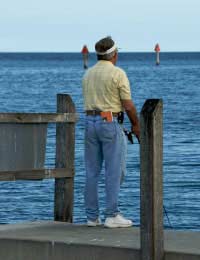Equipment for Sea Fishing

The seas around our coast provide opportunities to fish for many species of every shape and size.
There are two categories in sea fishing: shore fishing and boat fishing. Shore venues include beaches piers, harbours, jetties and estuaries. Boat fishing could be short trips from holiday resorts catching mackerel, charter boats hired to sail along the coast or deep sea wrecking trips hunting for ling and conger eel.
Different habitats often mean different species. Different species can sometimes mean different methods of fishing. Sea angling equipment is basically the same for any situation, although size and strength of tackle might vary.
Rods
A dedicated shore angler will use a specialised beach-casting rod that is able to place bait beyond the breakers. Those with a passion for catching mullet in harbours and estuaries adapt their equipment to make it lighter and more sensitive.Choose a rod of less than 4 metres and this can be used on beach, pier, harbour and boat. By selecting a general-purpose rod the novice angler has the flexibility to try out a variety of fishing venues.
Reels
The main reels used are the fixed-spool reel and the multiplier. A sensible choice for the beginner is the fixed-spool reel because it is easier to use. Multipliers have a tendency to overrun in inexperienced hands. The result of overrunning is a tangled mess of knots and loops known as "a bird's nest".Fixed-spool reels have a simple arm system that picks up the line when the handle is turned.
Choose a large reel that can hold plenty of line. Sometimes a hooked fish will make a surging dash for freedom and strip off metres of line in seconds!
Deep water, snags on rocks, reefs and large fish can test a fishing line to the limit. Using a line with breaking strain of 20lbs. will give the angler a fighting chance.
Having scissors or nail clippers is useful to cut heavy duty fishing line and to snip off knot tails on hooks.
Hooks
There are many obstacles in the sea where hooks can become stuck. Often the angler's dream of a monster turns into a stubborn clump of seaweed, so a strong hook is important. Also, a hook needs to be large if a big bait is being used. Buy a selection of sizes, such as 4, 6 and 8, to match different bait and conditions.Some sea hooks have extra barbs on the shank. Take care because these barbs are sharp and can be a painful nuisance when baiting up.
Take a sharpening stone with you because after a while hooks become blunt.
Legering
The simplest method of sea angling is legering which is generally done from piers and harbours. A weight is tied close to the hook and this keeps the bait on the sea bed. The weights are called legers, bombs and leads. Some anglers have been known to use heavy nuts and bolts and even old sparking plugs for legering!Float Fishing
This is an effective method of catching fish from jetties and harbours. The float allows the bait to drift and so therefore covers more fishing areas than legering.Choose a large float so that it can support large baits. Make sure the float is brightly coloured so it can be spotted in tide swells and at distance.
Clothing
An important part of sea angling equipment is what you wear. Warm clothes, hats, gloves and waterproofs are essential in exposed places like piers and jetties. Rubber soled shoes or boots are important when fishing from rocks because they can be slippery with seaweed. Watch out for tides and sudden waves. Sensible sea anglers respect the sea.- Shads, Pirks and Other Lures
- Making and Using Particle Baits
- Using Dead Baits
- Making and Using Paste Baits
- Ten Top Tips for Sea Fishing Equipment
- Rod Accessories for Fishing
- What To Wear When Fishing
- Tents for Fishing
- Bait for Game Fishing
- Bait for Sea Fishing
- Equipment for Game Fishing
- Equipment for Coarse Fishing
- Bait for Coarse Fishing


Re: Float Fishing
So I'm relatively new to fishing, to be honest I used to go with my dad and he used to set my rod up for me. I never tied rigs or anything so I guess…
Re: Fishing Holidays: Your Questions Answered
hi, i;m looking at getting a travel rod for mainly sea fishing but i also want to fish the occasional small pond…
Re: Trout Fishing
Hi, I’m trying to find somewhere I can go spinning for trout. I live near Swindon and dont mind a bit of travelling. I’ve searched online and every I…
Re: Trout Fishing
Hi I'm looking to fined out more about fly fishing for mullet and sea trout in Christchurch harbour...thank you.
Re: Equipment for Game Fishing
I know nothing about fishing tackle can you recommend a good rod reels line for fishing in the amazon and rivers in Guyana for large…
Re: Trout Fishing
Hi, where I can find places for trout fishing in norfolk?
Re: Fishing for Chub
This is a really good website and from this ive been catching chub on slugs maggots casters and worms rated 10 out of 10
Re: Is Fishing From a Road Bridge Over a River Legal?
Is it legal to fish next to a bridge without a permit even though the river is permitted
Re: Fishing For Flatfish
Hi im new to the whole fishing game but have recently been hooked onnit as i had a good day out with a keen fisherman. Will i catch plaice by…
Re: Getting Children Involved in Fishing
where in East Anglia is a good place to start to practice and teach my 6 year old girl to spin fish (lure angling…